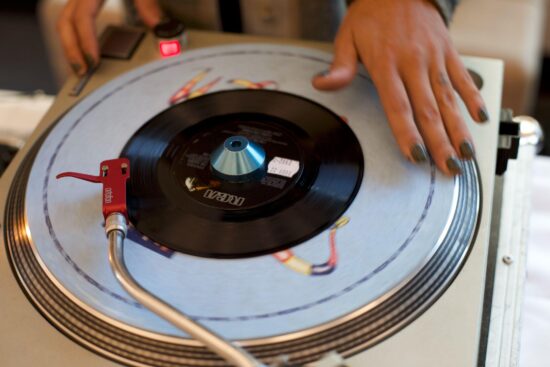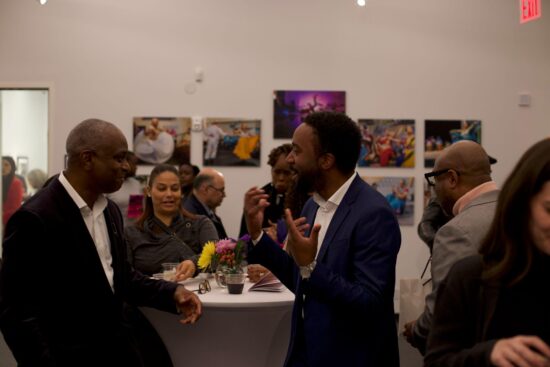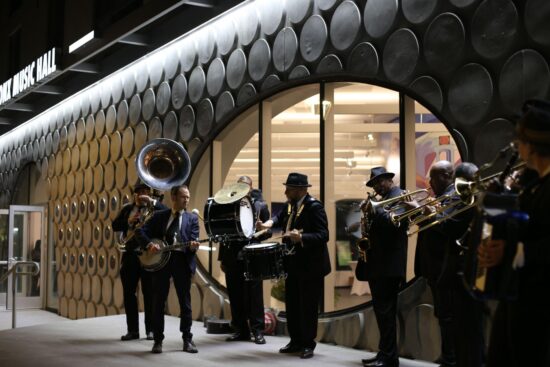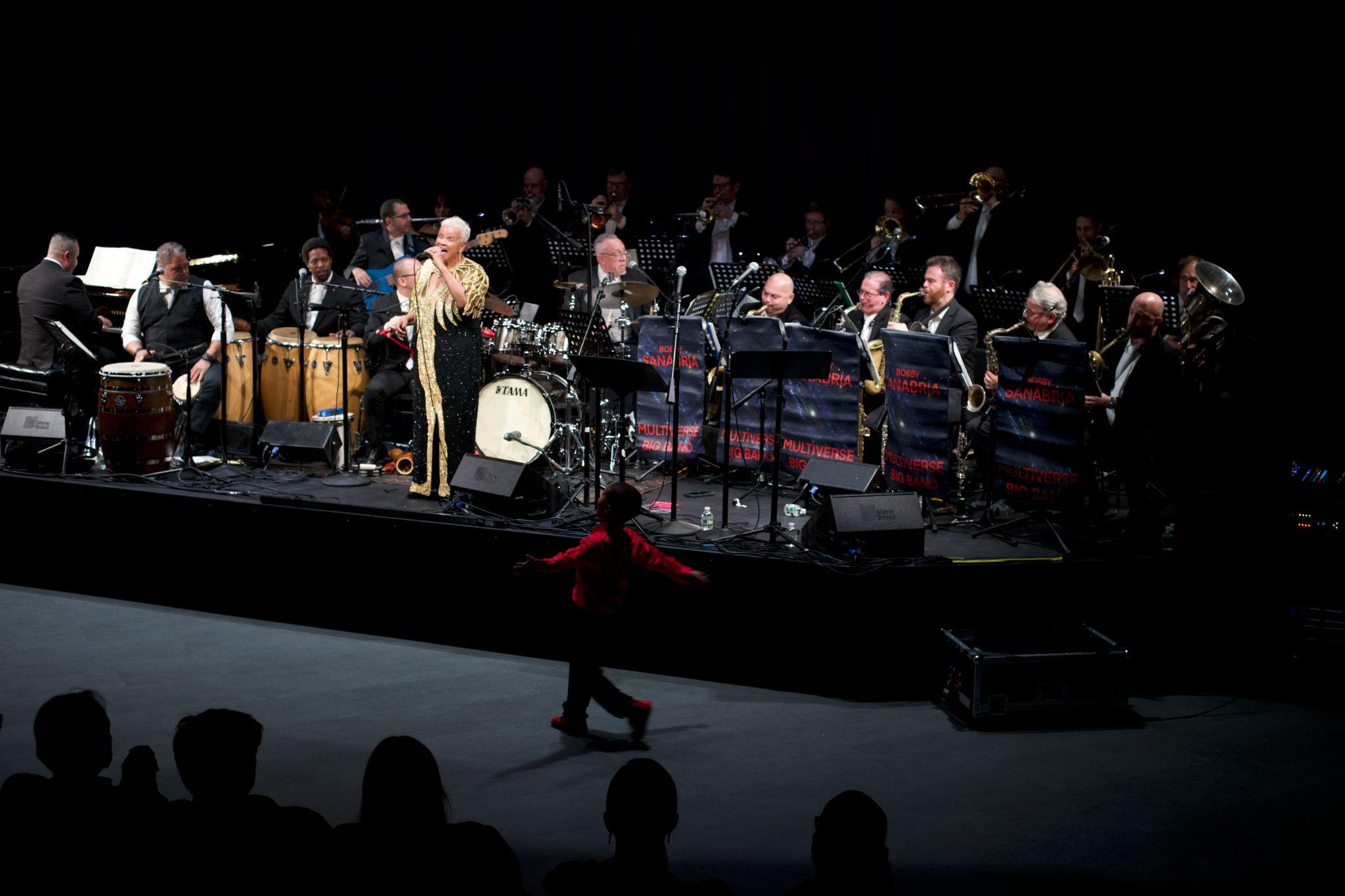The Women’s Housing and Economic Development Corporation has opened its new Bronx Music Hall. It aims to revitalize the neighborhood’s historically iconic music scene.
“Get over here. And dress to impress,” urged one senior Bronxite to a friend on the other end of his flip phone. It was opening weekend at the Bronx Music Hall, and the significance of the occasion was reflected in the finery: ball gowns, velvet suits, pearl necklaces, gold pinky rings, bedazzled jackets, African prints. This was the first time in 50 years that a new music hall had opened in the Bronx.
Located on the west side of Elton Avenue in Melrose, the Bronx Music Hall is a 14,000 square foot, $15.4 million venue. It boasts a 250-person capacity performance theater, a recording studio, rehearsal rooms, an outdoor amphitheater and plaza, and a green room. Its spacious lobby is adorned with a mural by Ecuadorian artist Luis Fernando Lechon depicting a Bronx musical legacy stretching back to indigenous traditions.
The hall is the newest project by the Women’s Housing and Economic Development Corporation (WHEDco), a Bronx nonprofit specializing in the conversion of city buildings and land into affordable housing. It’s part of their Bronx Commons, a multi-use premise that also includes 305 affordable homes as well as retail and recreational space.

When WHEDco acquired the space, Founder and President Emeritus Nancy Biberman knew she wanted it to feature a musical center that could do justice to the Bronx’s musical legacy. At their first meeting, she told her architects at WXY Architecture + Urban Design that “the talent of the musicians in the Bronx needs to be matched by a great venue.”
Biberman’s, and current WHEDco President Davon Russel’s, commitment to including music in the organization’s programming started back in 2008, when her longtime friend, Professor of African & African American Studies Mark Naison, played the WHEDco staff a cassette tape. His recordings captured some of the magic of those years when immigrants from the American South, Puerto Rico, Cuba, and the Caribbean were migrating to the Bronx and sharing their music on street corners, fire escapes, and clubs, before the disinvestment of the 1970s and ‘80s.

“There were probably 50 to 100 venues in the Bronx, small and large, where you could hear live music performed on a regular basis in different neighborhoods. And that live music was really part of the lifeblood of the borough,” said Biberman.
At a panel during opening weekend, Naison spoke about this generative past.
“In 1945 on Prospect Avenue you had Club 845, which had the best jazz musicians of that era from John Coltrane and Dizzy Gillespie to Dexter Gordon… And then you had the Hunts Point Palace [with] Tito Rodriguez, Thelonious Monk…” The local public schools also loomed large in the Bronx music scene during that era.
“PS 99 had a night center which one singer/author described as the Motown of the Bronx because of the talent shows they had…Coming out of Junior High School 52, you had the beginnings of salsa,” recalled Naison. But now, “there’s no more theaters and they’re no more music programs in the schools. All the preconditions for this unprecedented burst of musical creativity were gone.”
Seven-time Grammy-nominated Latin-jazz percussionist and Broxite Bobby Sanabria attributes the decline of the scene to former mayor Rudy Giuliani’s draconian approach to law and order.
“When I was growing up, you heard the conga drums all over the place in the summertime,” Sanabria said, adding that Giuliani’s government “outlawed public drumming,” as well as prohibited bodegas from playing music outside, and persecuted kids with boom boxes. “It was really racially biased and it killed the culture… That’s part of our mission – to bring all this culture back.”
WHEDco’s first step towards attempting to rejuvenate that culture was founding the Bronx Music Heritage Center, a cultural programming collective that has been housed at the Crotona Park East neighborhood for the past decade.
WHEDco brought on two artistic directors, Sanabria and his wife Elena Martinez, a curator, producer, and folklorist. Their programming has included live music performances, open mics and readings, film screenings, percussion and dance classes, and theater workshops. In just the past couple of months, there have been orisha dance classes, a concert by the Jalikunda Collective featuring musicians from Gambia and Mali, and a screening and conversation with “Style Wars” producer Henry Chalfant.
The pair will continue this programming at the new Bronx Music Hall. Their first project was the curation of the opening weeknd’s music program. “The way it was structured– it was that we would trace the music’s roots from Africa through New Orleans, through Cuba and Puerto Rico and New York City,” said Sanabria. Opening night attendees watched a performance by the Afro-Haitian Roots Music band, Kongo. Hip Hop legends Grandmaster Caz and MC Sha-Rock also performed, emphasizing the Bronx’s status as the birthplace of hip-hop.
The following evening, a New Orleans second line brass band called The Individuals of Peace led a procession from the outdoor plaza to the auditorium. “New Orleans is the outgrowth of Haiti,” explained Martinez. The procession culminated in the introduction of the Bobby Sanabria Multiverse Big Band (with special guest David Amram). The multi-grammy nominated group represents a fusion between North American, Caribbean, and Cuban music, particularly in the form of Latin jazz.

The next day, said Sanabria, “the finale was going back to Africa,” with performances by the Ghanaian Yawuza Alhassan & the Wuza Wuza Ensemble and Garifuna Grupo Maburuaña.
In a speech before the ribbon cutting ceremony, Bronx Borough President Vanessa Gibson noted that, “Many times our families cannot afford to go to theaters and other places in this city, but guess what? They have their own Bronx Music Hall – right here in their own community.”
Lena Amanquah, who grew up in the Bronx, could hardly contain her enthusiasm. “You weren’t expecting it. Like the caliber and the level is just ridiculous…[the sound quality] was phenomenal, it really sounded like a concert hall.” She sees it as a piece in a larger trend of renewal. “The Bronx is being revitalized. You’re doing so much, and this is just extra, something added… I’m just so excited, you know?”

